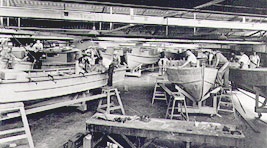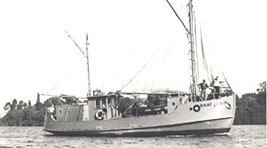Slazengers Shipyard
Mobilising Industry for War
The Australian government entered the 1939-1945 world war with a plan to mobilise the nation's industrial resources in support of the war effort. Special factories, referred to as annexes, were established in close association with existing industrial plants and with state bodies such as the railways. These annexes were managed by industry on behalf of the Australian government. At the same time the scheme allowed government to keep check on the costs of production and to exercise some control over profits. By these measures the Australian government hoped to prevent the growth of a large private munitions industry and to avoid building huge factories that would be useless after the war.
Slazengers on Service
Slazengers main plant was at Alexandria in inner-city Sydney. It was here that the company began its war time production making rifle and Bren gun components and ammunition boxes. In an annexe adjacent to this plant the company made filter pads for anti-gas respirators and at Empire Timbers Limited in Balmain they handled aircraft timbers for RAAF gliders. In 1942 the company ventured into shipbuilding. Although they had no previous experience in this field, Slazengers considered that their specialised knowledge of precision woodwork made them a suitable firm for handling some types of small ship fabrication.
 Photo: Aerial view of Slazengers' shipyard at Putney on the Parramatta River NSW around 1945. photo courtesy of Dunlop Slazenger Australiasia
Photo: Aerial view of Slazengers' shipyard at Putney on the Parramatta River NSW around 1945. photo courtesy of Dunlop Slazenger Australiasia
By adapting the techniques of laminating wood that they used in making tennis racquets Slazengers were able to build hulls for a variety of small boats. Company executives travelled to the United States to study methods of plywood manufacture and in 1942 they took out a patent for a special type of plywood barge.
By early 1943 the company's shipbuilding work was expanding. They had orders for the production of towboats, assault boats and punts as well indications that further orders would follow. The rowboats and assault boats were made at Alexandria but more space was needed for the punts. Thus in January 1943 Slazengers leased 6 acres of waterfront land on the Parramatta River at Putney, with a frontage to Pellisier Road.
The Putney site was cleared, the land fenced, and slipways, moorings, rails, wheels, axles and girders were put in place for production lines. By March 1943 production was underway with an initial group of 41 men, working under improvised conditions using hired marquees as temporary protection for men and materials against the weather.
The men were fabricating 45ft plywood punts for the United States Army. These were destined for use in the Pacific where small craft were playing an increasingly important role. As the war intensified the United States placed more and more demands on the Australian shipbuilding industry for a variety of small craft. The Australian government then formally decided to establish the Putney project as a wholly owned government works managed by Slazengers on behalf of the Australian Shipbuilding Board. Construction and storage sheds, change rooms, shower and washing facilities, mess rooms and a lavatory block were built.
The full workforce at Putney comprised around 80 shipwrights and painters and dockers, some of them sent to the site by the government's Manpower Directorate. A general problem of shortage of skilled labour in the shipbuilding industry had been met by the government through a training program whereby retired boat builders and shipwrights were recalled from their seclusion to teach cabinet makers, joiners and carpenters how to use broad axes and adzes and how to shape and bend timber. Manpower also supplied a small number of blacksmiths and engineers.
 Photo: High speed boat built for the R.A.A.F. at Slazengers shipbuilding annexe around 1945
Photo: High speed boat built for the R.A.A.F. at Slazengers shipbuilding annexe around 1945
Soon after production had begun at Putney, Slazengers enlisted a local Putney boatbuilder, Bill Fisher, to act as foreman shipwright in charge of the site. As well as overseeing the fabrication of the punts Bill also witnessed the introduction into Australia of a method of impregnating timber with creosote. This process enabled punts to be 'tropic proofed' against infestation by teredo worm. The creosote used in this process was manufactured by Timbrol Ltd at Rhodes.
Towards the end of 1944 work began at the Putney site on an order for motor scows for the R.A.A.F. These boats were 56ft long with an 18ft beam, built of 2 inch oregon sheathed on the bottom with copper and fitted with an 160 h.p. diesel motor. They too were destined for the war in the Pacific. Six were completed and another 27 were in production when the war ended in 1945.
The shipyard closed with the end of the war. Bill Fisher returned to his own business nearby where he continued to build boats until his death in 1992 at the age of 86.
Written by Megan Martin, former Local Studies Librarian, Ryde Library Services, based on resources held in the Ryde Library Services Local Studies Collection, as at April 1994.